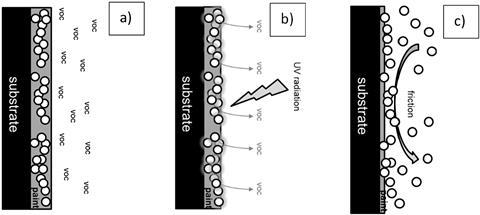Photocatalytic paints for reducing air pollution may actually do the opposite
A study by scientists in France and China has raised questions about the effectiveness of paints formulated to combat air pollution. Whilst the paints decompose some pollutants, the research revealed they also generate and release other toxic compounds.
Urban air pollution is a common problem in many of the world’s cities; vehicles and power stations are the primary culprits. Titanium dioxide nanoparticles, when exposed to UV light, can oxidise organic compounds in the air. When added to paint, they present a quick fix for reducing air pollution. However, the overall improvement to air quality is dubious.

So says Sasho Gligorvoski, from the Chinese Academy of Sciences, and his team who have found that photocatalytic paints release significant quantities of nanoparticles and volatile organic compounds (VOCs) over their lifetime. This is especially problematic indoors, where the chemicals accumulate over time.
The scientists used xylene as a model compound to test the titanium dioxide nanoparticles’ ability to eliminate VOCs from the air. From their results, they hypothesised that UV radiation activates the nanoparticles, causing them to emit hydroxyl radicals. These radicals attack both VOCs in the air, as well as organic compounds in the paint. So while the paint eliminates xylene, the reactions behind this process create a series of new VOCs and also degrades the surface of the paint, releasing nanoparticles. Formaldehyde is among the new VOCs they identified, which is an irritant and classed as a carcinogen.
‘Photocatalytic paints are an excellent example of a treatment technology using sustainable energy as they only require sunlight or ambient lighting to work. However, the issues presented here challenge the usefulness of the titanium dioxide-based photocatalytic paints as a remediation technology to improve urban and indoor air quality. Lots of effort is needed to make this technology viable for air quality improvement,’ comments team member Delphine Truffier-Boutry from Grenoble Alps University in France.
‘This research has significance from the perspective of controlling indoor pollution caused by commonly used photocatalytic wall paint materials. Metal nanoparticles and several VOCs are carcinogenic,’ remarks Nishith Verma, an expert in catalysts for removing air pollutants from the Indian Institute of Technology in Kanpur. ‘The manufacturers of such types of paints may consider tailoring the synthetic route to minimise the degradation of photocatalytic paint materials.’
Bernd Nowack, a specialist in environmental risk assessments of nanoparticles from at the Swiss Federal Laboratories for Materials Science and Technology adds: ‘Only large-scale studies will be able to show if these paints really have any effect on air pollution – modelling will be very important here. The study could provide some of the input data for these models or help to design the large-scale studies.’
Gligorvoski’s group hope to find a way to stop photocatalytic paints from releasing harmful by adopting a safer-by-design approach to nanoparticle fabrication, and are working closely with paint manufacturers to achieve this.
References
This paper is free to access until 13 October 2017
D Truffier-Boutry et al, Environ. Sci.: Nano, 2017, DOI: 10.1039/c7en00467b












2 readers' comments